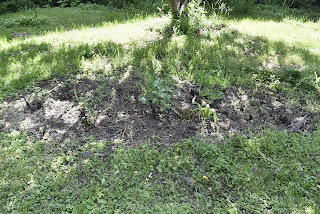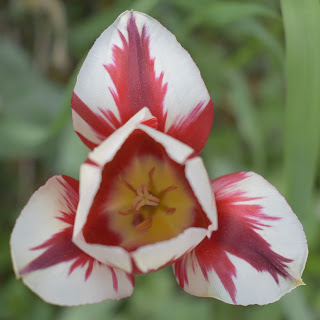1. Spring cleaning and purging - inside the home as well as outdoor (hobby shed, barn, and tractor shed).
Well...this goal was a bit different than anticipated this year. We had a fire at our farm which destroyed the hobby shed and playhouse. So much for Spring cleaning and purging what we no longer need. That was done for us by the fire.
There was a demo crew that had a machine that picked up and put the charred remnants of the shed and playhouse into the dumpster.
It took two dumpsters to haul away everything. There's a bit more that needs to be removed from the shed and fire pit; and that will probably fit into one more dumpster.
The fire also burned half of the front of the barn and half of one side of the barn.
A gentleman from the local Lions club came out to help with cleaning out all the water-soaked hay and straw from the barn. It was soaked because the firefighters saturated it with water so the fire that was already burning the barn wouldn't jump to the hay and straw and quickly ignite the entire barn.
We pushed out all the damaged hay and straw out the loft door.
A few days later, the gentleman from the Lions club came back with his Bobcat and moved all the water-saturated hay and straw.
He moved it away from the barn to a new compost area.
I do need to clean out the feed room and the section of the barn that holds other items and tools. The little shed behind the barn also needs to be cleaned out still, but that isn't a top priority given what happened with the fire.
2. Muck out the barn.
On May 16th, we cleaned out one-third of the barn. The meant removing all the wood chips that the horses had used for bedding during the winter. Up until mid-April, the bedding was frozen since we had an abnormally cold and long winter. So, we were late this year with cleaning out the barn thoroughly.
The girls started cleaning the barn and removing everything down to the thick, rubber mats.
I - along with another gentleman from the local Lions club - worked on another section of the barn. After he left, I finished mucking out about half of the barn and putting down fresh bedding. On Memorial Day weekend, I finished the other half of the barn and put the rest of the bedding down. It is much better now.
When the Bobcat was here, all the used bedding was moved to our primary compost pile.
There were many different piles were we put the used bedding when we were removing it from the barn. These were all cleaned up.
Afterwards, he smoothed out the area where the horses spend a lot of time. They didn't seem to mind the Bobcat moving around the pasture.
On Memorial Day weekend, I finished mucking out the barn. It felt great to get all the bedding out of the barn and to the compost pile. It looks (and smells) better now with fresh bedding.
3. Replace the numbers on the mailbox after they were damaged from the snow and then the heat from the fire.
The numbers were either missing or starting to peel off from the mailbox.
I replaced all the letters and numbers so they are affixed to the mailbox.
It looks so much better now.
4. Tune up/service the lawn tractor.
The last time that I was able to use the mower was in Fall 2016. Last year, at the start of the season, the mower didn't work. With the service technician I normally used no longer operating his own business, I was at a loss for how to fix the riding mower. So, I hired someone to mow our lawn.
A neighbor showed me how to check and/or charge the battery and it was fine. Yet, the mower didn't start. So, we finished out the 2017 season with someone else mowing the lawn.
This year, because of the fire, we had many Lions Club members helping. One asked about our lawn since he noticed the grass was long. He took the battery and checked it (it was fine); and then came back to look at the lawn mower.
He was able to fix it (a wire came out of the fuse and so it wasn't able to start). Because he knew how to splice wires and connect them, the mower was able to start up again. By the time I was able to mow our lawn for the first time this season, it looked like a hay field - with grass as tall as my knees in some areas.
In the photo below, Aspen is walking in an area I did the first cut through. It was still long, but not anything like the "hayfield" I was growing.
After I mowed it for the second time, it was a much more acceptable length. There was still a lot of grass laying in piles all over the lawn, so the girls and I raked up everything; and then hauled the cut grass to an area next to the driveway. In this way, the lawn has a chance now to get sun, water, and air; and the horses can't get to the cut grass which would make them sick (too much and too rich/high in sugar).
I should have taken a before and after picture. The lawn looks significantly better now that it is raked.
Now, the next step is to buy a weed trimmer (since ours burned in the fire) and do trimming.
5. Repair and/or replace the pasture fence.
Part of the pasture fence was damaged in the fire. There are sections that are missing and that we've had to use baling twine to string across to create a temporary fence. Thankfully, this section of the fence is just between the west pasture and the area by the barn. It's hard to tell where the fence was and where it needs to be fixed.
In another section, the wood posts were charred, so that length of fencing will all need to be repaired. We have t-posts and chicken wire up temporarily until the fence can be fixed.
I'm looking forward to this Fall when things should look significantly better.
6. Prepare the garden beds - create new ones and build new raised beds.
This one doesn't look like much right now because it is the rose bed that burned in the fire. At least the weeds are removed.
There were perennials in this garden that I hoped would grow, but it looks like the fire was too hot for them to survive. Looks like new roses and perennials will need to be planted.
That being said, there were two roses that did come up which made me happy. These were ones that my Dad tended to for many years, and I took care of after he died and until my Mom died. I transplanted them here so we could continue to enjoy them.
The flower bed next to the roses is filled with yellow irises from my parents. They are doing well this year. I had transplanted them in October 2016. In 2017, they didn't do too well - just shot up some leaves. This year, however, they have been blooming for quite some time now which is great!
We have another type of wild iris that grows in the west pasture: Blue Flag Iris. These have been spreading and doing exceptionally well each year.
When we first moved here, I don't remember seeing any. Now, they are prolific.
I am hoping to continue to work with different gardens around the front- and backyards. There are many and has not been enough time to work on them. Perhaps later this month I can make some progress on them.
Even so, there are some flowers coming up in the gardens - like wild columbine:
and tulips.
7. Plant seeds or transplants.
I didn't take photos of planting the seeds or transplants because I was the only one who did it. There are four 4'x3' gardens that are planted with tomatoes (4 types), green peppers, jalapenos, about a dozen herbs, green beans (2 types), yellow beans, carrots (2 types), cucumbers, zucchini, and watermelon.
There were three gardens that were damaged in the fire, so I need to transplant the two rhubarb plants, and then find a place for all the dirt. The space where the gardens are now will be part of the driveway and entry to the new garage.
8. Clear out the fire pit and make it smaller.
When the Bobcat was here, we had the fire pit cleaned up. It was a big job because we've been using the same fire/burn pit since we moved here in 1995.
Needless to say, there were multiple loads that were removed and put with the rubble from the shed. We had hoped that it would be hauled away when the rubble was taken, but the demo crew needed another dumpster.
I spent some time picking through the dirt and found broken glass, rusty nails/screws/metal, and other items that needed to go into the trash. We still have some more work with this area - picking up any more garbage, leveling it out, and then putting grass seed or sod on it.
We won't be doing any more large-scale burning at this point in our lives. Even though the shed fire wasn't our fault and not a result of our burning, doing a large fire doesn't hold the same appeal it once did. Making a small fire pit that we can sit around and enjoy, and make some food over seems more relaxing.
9. Make repairs to any buildings damaged during the winter; and then paint them.
Because of the fire, we are starting from scratch for the shed-turned-garage. The barn, which also was damaged, will be power-washed once it is repaired and then painted. With new windows and doors on the front, loft doors fixed, and holes in the siding repaired, it should completely change the way the barn looks.
We hope that this project will be done by late-July or early-August.
10. Start splitting and stacking wood.
We will start on this project in the late-Summer or early-Fall when



























1 comment:
Wow! There is so much work when you own land in the first place and this was a lot more. So awesome that you had help from volunteers. Priceless!!! And I am thrilled that the roses didn't die and you still have other flowers coming back. A lot of hard work. Things are going to look different. I am so glad the horses were okay. It could have been so much worse without your wonderful neighbor! You guys are truly blessed. :)
Post a Comment